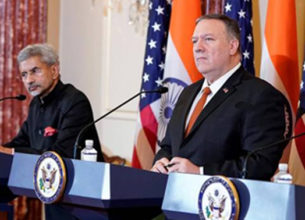INDIA – JAPAN: 2+2 DIALOGUE
02, Dec 2019

Prelims level : India Bi-lateral Co-operations
Mains level : GS-II Bilateral, Regional and Global Groupings and Agreements Involving India and/or affecting India’s interests
- India and Japan held their first ever Foreign and Defence Ministerial Dialogue (2+2), to discuss on the issues relating to defence and security, and other issues of mutual interest. The 2+2 ministerial dialogue is seen as an upgrade of the meeting between foreign and defence secretaries of the two countries, which is in place since 2010.
- The upgrade is said to be the outcome of the 13th India-Japan Annual Summit held in Japan, in October 2018, between Prime Minister Narendra Modi and his Japanese counterpart Shinzo Abe. Japan is only the second country (after the US) with which India has such a dialogue format.
- Quad, as one of the elements of Indo-Pacific strategy for “a free, open and rules-based order” in face of an aggressive and expansionist China in the region, should eventually evolve into a ministerial-level dialogue imbued with a strong military dimension.
India- Japan Relations:
- In spite of having ‘close-to-littoral’ policies of the past, India, realizing the importance of far reaching maritime ties with other Indo-Pacific nations, has had a close relation with Japan.
- The India-Japan 2+2 dialogue is an endorsement of the special strategic partnership between New Delhi and Tokyo. The dialogue, mainly, has been driven by the mutual desire to take forward Asia as a multi-polar region and ensuring a free, open, and inclusive Indo-Pacific realm.
- India and Japan continue to enjoy healthy maritime ties underscored by amity and trust with the two nations conducting annual bilateral naval exercise-JIMEX since 2012 and the formal inclusion of Japan into the MALABAR exercise in 2015 (India, US and Japan).
- The defence exercises between the two nations include the Dharma Guardian land exercise and the Shinyu Maitr air exercise.
India and its Sphere of Influence in the Indo-Pacific:
- The rise of China, the realignment of US’ global strategy, the new approach adopted by Japan, ASEAN, France and other key players have further underlined the importance of the Indo-Pacific region.
- China has increasingly active presence in the Indian Ocean region and also extends its efforts to expand its geopolitical reach in Asia and beyond, by the use of trade and military.
- India, also has a significant presence in the Indian Ocean and it is emphasizing regional connectivity and growth through – Security and Growth for All in the Region (SAGAR). This has made India, an option to counter the threat of unipolarity posed by China.
- India, in recent years, understanding the salience of the region has moved from being a reluctant maritime power to a conscious one. It has sought to align its Indo-Pacific strategy with national maritime interests, and has developed partnerships accordingly.
- India, also has created a nexus of common goals amongst different nations in South East Asia. And exercising its role as net security provider, is expanding its current sphere of influence. India’s quick response to humanitarian disasters, piracy issues, evacuating civilians from conflict zones, and securing SLOCS, have displayed its capabilities as the net provider of security.
- The US believes the Quad (Japan, India, United States and Australia), as one of the elements of its larger Indo-Pacific strategy for “a free, open and rules-based order” in face of an aggressive and expansionist China in the region.
India – Japan: Defence Trade:
- The sale of the ShinMaywa US-2 amphibious aircraft for the Indian Navy, is yet to be concluded. India’s purchase of the aircraft could see enhance India’s capability of the humanitarian assistance and disaster relief (HADR)
- Further, the two have established a working group to study the possibilities in Visual Simultaneous Localization and Mapping (SLAM) Based Global Navigation Satellite System (GNSS) Augmentation Technology for UGV/robotics.
- The Acquisition and Cross-Servicing Agreement (ACSA), which will enhance the strategic depth of bilateral security and defence cooperation between the two nations, is still in its development stage.
- Opportunities in the areas of technology collaboration is significant. With India’s domestic defence electronic manufacturing segment still at a nascent stage, it has to partner with its strategic partners in building a domestic capability base.
- Japan is also pushing for India to join the Regional Comprehensive Economic Partnership (RCEP) and is making talks with other countries that are part of the deal to ensure that India’s concerns are addressed.
What stops Japan?

- Article 9 of the Japanese Constitution declares that “the Japanese people forever renounce war as a sovereign right of the nation and the threat or use of force as means of settling International Disputes”.
- The Japanese Prime Minister Shinzo Abe, wants to change the provisions to make Japan just as normal as other democratic countries. But any attempt to revise the constitution would be politically risky. And these amendments require approval of two-thirds of both houses of parliament and a majority in a referendum.
- Overall, the India-Japan ministerial level 2+2 strategic dialogue is an important initiative emphasizing the deep interest in both India and Japan to further strengthen their security and strategic engagements. The two countries have built a strong strategic partnership in the last decade. But India and Japan also need to build a larger coalition if they are to balance China effectively.







